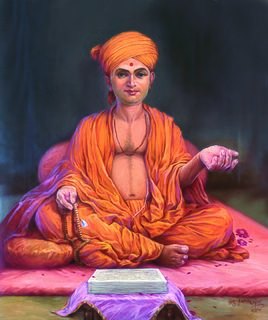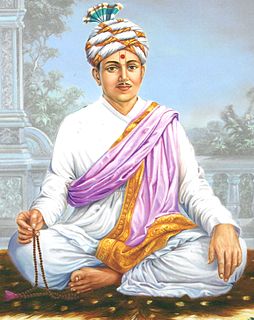
Bochasanwasi Akshar Purushottam Swaminarayan Sanstha, is a Hindu denomination within the Swaminarayan Sampradaya. It was formed in 1905 by Yagnapurushdas following his conviction that Swaminarayan remained present on earth through a lineage of gurus starting with Gunatitanand Swami.

Pramukh Swami Maharaj was the guru and Pramukh, or president, of the Bochasanwasi Akshar Purushottam Swaminarayan Sanstha (BAPS), a major branch of the Swaminarayan Sampradaya, a Hindu denomination. BAPS regards him as the fifth spiritual successor of Swaminarayan, following Gunatitanand Swami, Bhagatji Maharaj, Shastriji Maharaj, and Yogiji Maharaj. He was believed by his followers to be in constant communion with Swaminarayan, and ontologically, the manifestation of Akshar, the eternal abode of Swaminarayan.

Swaminarayan, also known as Sahajanand Swami, was a yogi and ascetic around whom the Swaminarayan Sampradaya developed, and whose life and teachings brought a revival of central Hindu practices of dharma, ahimsa and brahmacarya. He is believed by followers to be a manifestation of God.

Yogiji Maharaj, born Jina Vasani, was a Hindu swami and the fourth spiritual successor of Swaminarayan in the Bochasanwasi Akshar Purushottam Swaminarayan Sanstha (BAPS), a major branch of the Swaminarayan Sampradaya. According to the metaphysics of BAPS, Yogiji Maharaj is considered to be the next iteration of Akshar after Shastriji Maharaj in the guru parampara, an unbroken line of "perfect devotees" who provide "authentication of office through Gunatitanand Swami and back to Swaminarayan himself." Together with Pramukh Swami Maharaj, who acted as the administrative head of BAPS, he was instrumental in nurturing the growth of BAPS "through new programs, expansion into new areas, and the construction of temples". As guru, he consecrated over 60 temples and visited over 4000 towns and villages. He was particularly effective in attracting the devotion of youths and initiated a large number of them as ascetics. Furthermore, his multiple tours to Britain and East Africa were integral in the overseas expansion of BAPS. He died on 23 January 1971 after appointing Pramukh Swami Maharaj as his successor.

Gunatitanand Swami, born Mulji Jani, was a prominent paramhansa of the Swaminarayan Sampradaya who was ordained by Swaminarayan and is accepted as the first spiritual successor of Swaminarayan by the Bochasanwasi Akshar Purushottam Swaminarayan Sanstha (BAPS). Born into a religious family in the small farming community of Bhadra in Gujarat, India, he first received religious education under his father's guru, Ramanand Swami before encountering Swaminarayan and becoming a swami under him at the age of 25. He was revered for his spiritual discourses and divine service

The Vachanamrut is a sacred Hindu text consisting of 273 religious discourses delivered by Swaminarayan from 1819 to 1829 CE and is considered the principal theological text within the Swaminarayan Sampradaya. Compiled by four of his senior disciples, Swaminarayan edited and approved the scripture. As followers believe Swaminarayan to be Parabrahman, or God, the Vachanamrut is considered a direct revelation from God and thus the most precise interpretation of the Upanishads, Bhagavad Gita, and other important Hindu scriptures.

The BAPS Shri Swaminarayan Mandir of Chicago, Illinois is a traditional Hindu place of worship built by the BAPS Swaminarayan Sanstha. The BAPS Swaminarayan Sanstha, which is headed by Mahant Swami Maharaj, is a denomination of the Swaminarayan branch of Hinduism. The mandir, located in the Chicago suburb of Bartlett, opened on 7 August 2004. It is built of hand-carved Italian marble and Turkish limestone. The mandir is the largest of its kind in Illinois and was constructed according to guidelines outlined in ancient Hindu texts of temple architecture. The complex spreads over 27 acres and, in addition to the mandir, includes a haveli, a small bookstore. The haveli is a cultural center in which weekly congregations are held. The mandir is open daily for worship and to visitors.

Shastriji Maharaj, born Dungar Patel and ordained Shastri Yagnapurushdas, was a swami of the Swaminarayan Sampradaya and founder of the Bochasanwasi Akshar Purushottam Swaminarayan Sanstha (BAPS). Several branches accept him as the third spiritual successor of Swaminarayan in the lineage of Aksharbrahma Gurus through whom Swaminarayan manifests, which began with Gunatitanand Swami. Born in a family of farmers in central Gujarat, India, he became a swami within the Vadtal diocese of the Swaminarayan Sampradaya at the age of 17 where he was given the name Yagnapurushdas Swami. The prefix Shastri was later added in recognition of his eminent scholarship in Sanskrit and the Hindu scriptures. He established BAPS after a doctrinal split from the Vadtal diocese of the Swaminarayan Sampradaya.

The BAPS Shri Swaminarayan Mandir in Atlanta, Georgia is a traditional Hindu mandir, or place of worship, inaugurated on 26 August 2007 by the BAPS Swaminarayan Sanstha, a denomination of the Swaminarayan branch of Hinduism headed by Mahant Swami Maharaj. The mandir located in the Lilburn suburb of Atlanta, was constructed in accordance with ancient Hindu architectural scriptures, and is the largest mandir of its kind outside of India. The mandir is made of 34,450 pieces of hand-carved Italian marble, Turkish Limestone and Indian pink sandstone, situated on landscaped grounds spread over 30 acres. The mandir complex also includes a large assembly hall, family activity center, classrooms, and an exhibition on the key tenets of Hinduism. The mandir is open daily for worship and to visitors of any faith.

The Swaminarayan Sampradaya, also known as Swaminarayan Hinduism and Swaminarayan movement, is a Hindu Vaishnava sampradaya rooted in Ramanuja's Vishishtadvaita, characterized by the worship of its charismatic founder Sahajanand Swami, better known as Swaminarayan, as an avatar of Krishna or as the highest manifestation of Purushottam, the supreme God. According to the tradition's lore, both the religious group and Sahajanand Swami became known as Swaminarayan after the Swaminarayan mantra, which is a compound of two Sanskrit words, swami and Narayan.

The Swaminarayan mantra, "Swaminarayan," is a mantra used by the Swaminarayan Sampradaya. It is a compound of two words: Swami and Narayan, that is, Vishnu c.q. Purushottam. According to the Swaminarayan-tradition, the Swaminarayan Mantra was introduced and explained by Swaminarayan, also known as Sahajand Swami, spiritual head of the Swaminarayan Sampradaya, shortly after the death of his predecessor, Ramanand Swami. Devotees chant the Swaminarayan mantra to offer worship, to allay distress, to pray for the welfare of others, and at the end-of-life. Several scriptures of the Swaminarayan Sampradaya, such as the Swamini Vato, Harililamrut, and Bhaktachintamani, describe the power and efficacy of the Swaminarayan mantra for one who chants it.
Yogi Gita, literally meaning “Yogi’s song”, refers to a collection of spiritual teachings and prayers of Yogiji Maharaj, the fourth spiritual successor to Swaminarayan. The Yogi Gita encapsulates the necessary attributes one must imbibe in order to progress spiritually and become Brahmarup or attaining the highest level of spiritual enlightenment. The Yogi Gita contains invaluable interpretations of Swaminarayan's teachings from the Vachanamrut. This, too, provides an expansive view of the Akshar-Purushottam Darshan, the doctrinal foundation of BAPS philosophy.

Bhagatji Maharaj, born as Pragji Bhakta, was a householder devotee in the Swaminarayan Sampradaya, a Hindu denomination. He is regarded as the second spiritual successor of Swaminarayan in the Bochasanwasi Akshar Purushottam Swaminarayan Sanstha (BAPS).

The Akshar Deri is a major site of pilgrimage in the Swaminarayan Sampradaya and is located in the rang mandap of the BAPS Swaminarayan temple in Gondal, India. The structure marks the cremation site and serves as a memorial to Gunatitanand Swami. An event was held to commemorate 150 years of the structure in Gondal, the structure as well as the site was renovated to bring it to modern standards.
The BAPS Shri Swaminarayan Mandir Christchurch is the third mandir in New Zealand of the Bochasanwasi Akshar Purushottam Swaminarayan Sanstha (BAPS). It is the only Hindu temple on the South Island of New Zealand. It officially opened on 26 June 2012.

Swaminarayan Akshardham in Robbinsville, New Jersey, is a Hindu mandir (temple) complex. The BAPS Shri Swaminarayan Mandir, one component of the campus, was inaugurated and opened to the public on August 10, 2014. Portions of the complex still under construction include the Akshardham Mahamandir and a visitor's center, which will include an exhibition on Hindu faith and culture.

Bhadreshdas Swami is a Sanskrit scholar and an ordained monk of the Bochasanwasi Akshar Purushottam Swaminarayan Sanstha (BAPS). In 2007 he completed the Swaminarayan Bhashyam, a five-volume classical Sanskrit commentary on the Prasthanatrayi. This commentary on Hinduism's three canonical texts: the Upanishads, Bhagavad Gita, and the Brahma sutras, forms the interpretive foundation of the philosophy of Akshar Purushottam darshana, also known as Swaminarayan darshana, illuminating the Vedic roots of the Akshar Purushottama philosophy, which was propagated by the 19th-century Hindu leader, Swaminarayan and later by Shastriji Maharaj.

Mahant Swami Maharaj is the present guru and president of the Bochasanwasi Akshar Purushottam Swaminarayan Sanstha (BAPS), a major branch of the Swaminarayan Sampradaya, a Hindu denomination. BAPS regards him as the sixth spiritual successor of Swaminarayan, following Gunatitanand Swami, Bhagatji Maharaj, Shastriji Maharaj, Yogiji Maharaj, and Pramukh Swami Maharaj. He is believed by his followers to be in constant communion with Bhagwan Swaminarayan, and ontologically, the manifestation of Akshar, the perfect devotee of God.

Akshar-Purushottam Darshan or Aksarabrahma-Parabrahma-Darsanam, "Akshar-Purushottam philosophy," is a designation used by BAPS-swamis as an alternative name for the Swaminarayan Darshana, Swaminarayan's view or teachings, to distinguish it from other Vedanta-traditions. It is based on Swaminarayan's distinction between Parabrahman and Aksharbrahman as two distinct eternal realities, which in this view sets Swaminarayan's teachings apart from other Vedanta-traditions. It is an essential element for the BAPS and it's Akṣara-Puruṣottama Upāsanā ("worship"), in which Purushottam c.q. Parabrahman is present in a lineage of Aksharbrahman guru's, who are the abode (akshar) of God.

The Swaminarayan Bhashyam (Svāminārāyaṇabhāṣyam) is a five-volume Sanskrit bhashya, or commentary, on the Prasthanatrayi (Prasthānatrayī) - the ten principal Upanishads (Upaniṣads), the Bhagavad Gita (Bhagavadgītā), and the Brahmasutras (Brahmasūtras) - which establishes the principles taught by Swaminarayan as perceived by the BAPS.

















